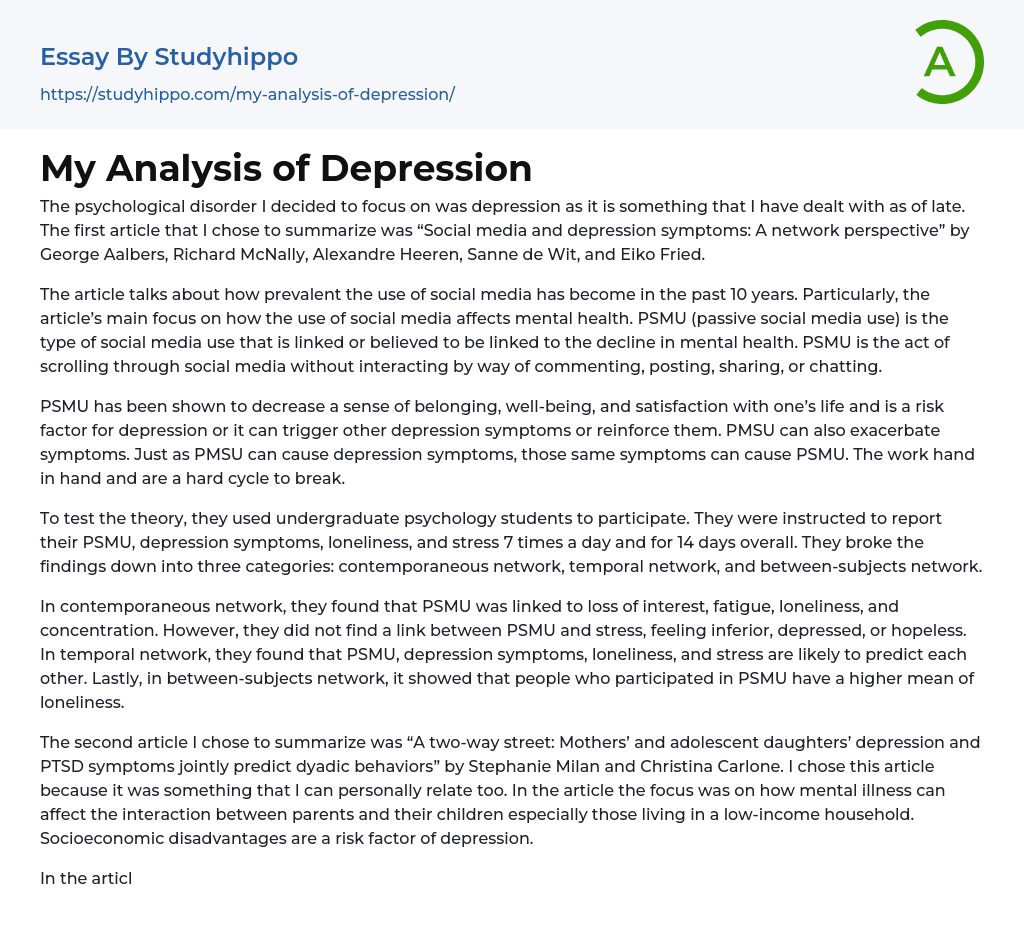The psychological disorder that I chose to concentrate on is depression because it is something that I have recently experienced.
In this summary, the research article "Social media and depression symptoms: A network perspective" authored by George Aalbers, Richard McNally, Alexandre Heeren, Sanne de Wit, and Eiko Fried is discussed. The article examines the extensive usage of social media over the last ten years and its influence on mental health. Specifically, it concentrates on the adverse consequences of passive social media use (PSMU) on overall psychological wellness. PSMU denotes the act of browsing through social media without actively participating via actions such as commenting, posting, sharing, or chatting.
Numerous studies have demonstrated that PSMU can diminish a person's feeling of belonging, overall well-being, and satisfaction in life. Additionally, PSMU carries the potential to act as a risk factor for depression, either by triggering its symptoms
...or by reinforcing existing symptoms. Furthermore, PMSU can worsen these symptoms. Conversely, depression symptoms themselves can induce PSMU. Therefore, these two elements mutually interact and form a challenging cycle that is difficult to break.
To investigate the theory, undergraduate psychology students were enlisted to participate. They were instructed to document their PSMU, symptoms of depression, feelings of loneliness, and levels of stress on seven occasions daily for a total of 14 days. The findings were categorized into three groups: contemporaneous network, temporal network, and between-subjects network. Within the contemporaneous network, a connection was observed between PSMU and experiences of disinterest, fatigue, loneliness, and lack of concentration. However, no correlation was found between PSMU and stress, feelings of inadequacy, depression, or hopelessness.
Researchers found that in a temporal network, there are predictive relationships between PSMU,
depression symptoms, loneliness, and stress. Additionally, a separate analysis showed that individuals who engaged in PSMU had higher levels of loneliness on average. The second article chosen for summarization is "A two-way street: Mothers' and adolescent daughters' depression and PTSD symptoms jointly predict dyadic behaviors" by Stephanie Milan and Christina Carlone. This article personally resonated with me and influenced my decision.
The article examines the impact of mental illness on the parent-child relationship, particularly in low-income households. Individuals in disadvantaged socioeconomic circumstances are more prone to experiencing depression. The article indicates that a mother's ability to provide warmth, affection, support, and communication is influenced by her symptoms of depression. Consequently, when a mother is depressed, she may exhibit hostility, inadequate communication skills, and coercion. These mothers have lower likelihoods of engaging in conversations with their daughters; if they do engage in conversation, it can become harsh. Therefore, if an adolescent shows signs of depression, the mother may face difficulties providing appropriate support.
150 mother-adolescent daughter duos from low-income households were included in the research. The average ages of the adolescents and mothers were 15 and 41, respectively. These duos represented diverse ethnic and educational backgrounds, including mothers who had children at a young age. The participants took part in semi-structured interviews, completed a survey (ACASI), and engaged in an interaction task. The adolescents also underwent assessment for depressive symptoms using the APS (adolescent psychopathology scale).
Using a 9-item Patient Health Questionnaire, the study assessed depressive symptoms in mothers and found that their adolescent daughters displayed higher levels of hostility. Additionally, the study revealed that the mothers' behavior could predict depression symptoms in their daughters about a month later.
However, there was no evidence to support the idea that the daughters' behavior could forecast depression symptoms in their mothers.
The study emphasizes the significance of considering the symptoms experienced by both the mother and daughter in order to gain a comprehensive understanding of how these symptoms may affect each other.
- Adhd essays
- Antisocial Personality Disorder essays
- Anxiety essays
- Bipolar Disorder essays
- Depression essays
- Depression And Anxiety essays
- Dyslexia essays
- Learning Disability essays
- Major Depressive Disorder essays
- Mental Disorder essays
- Mental Illness essays
- Psychosis essays
- Schizophrenia essays
- Stress essays
- Suicide essays




